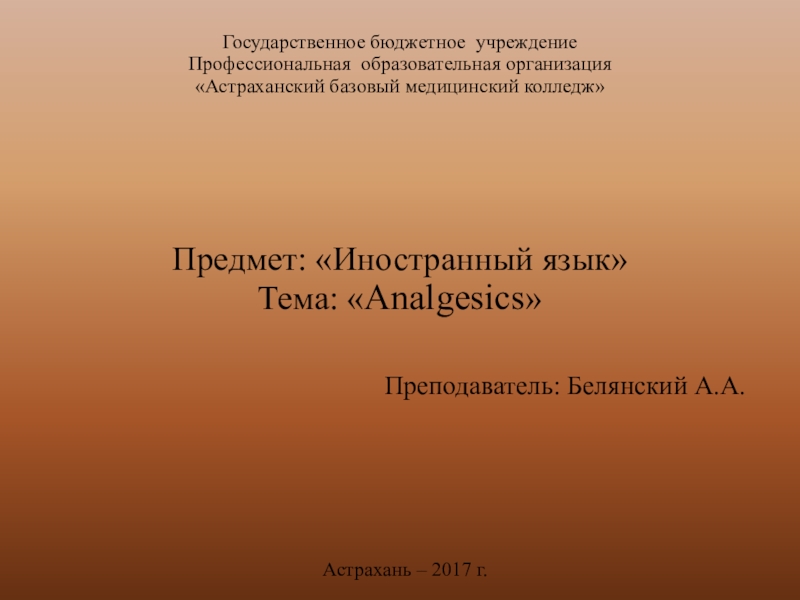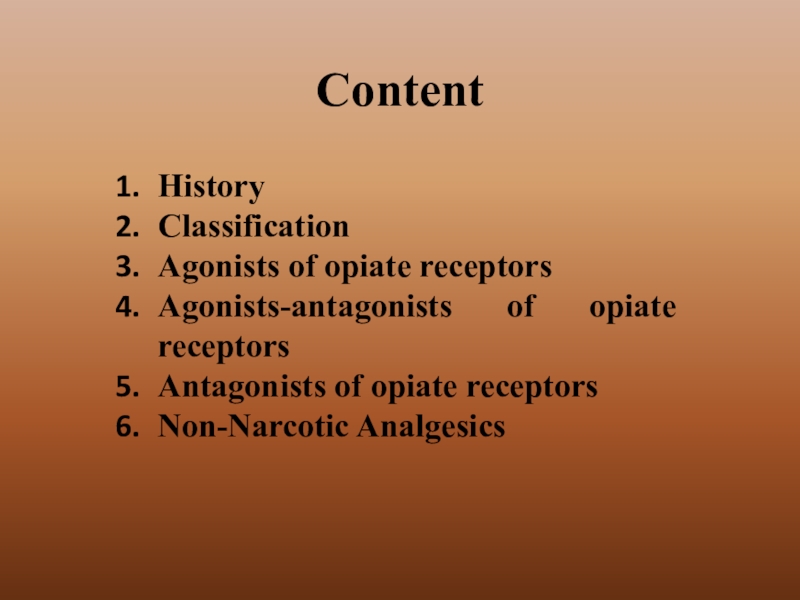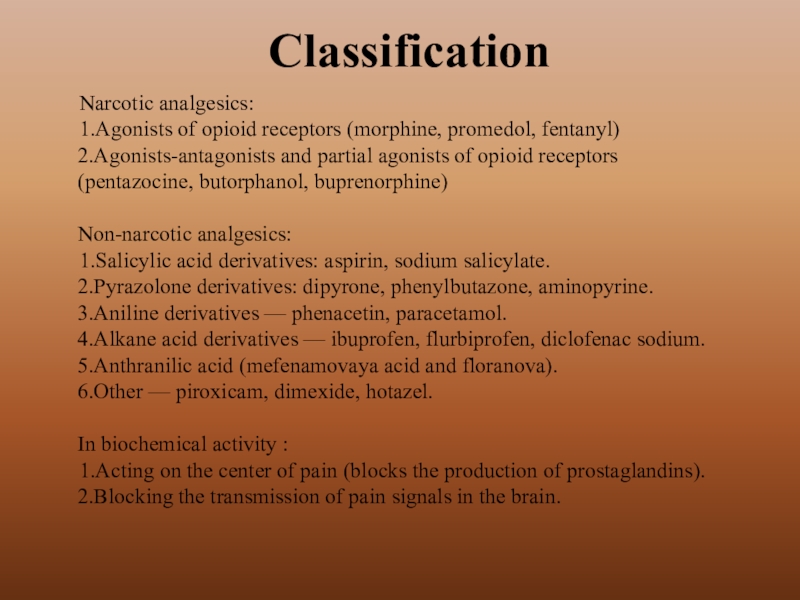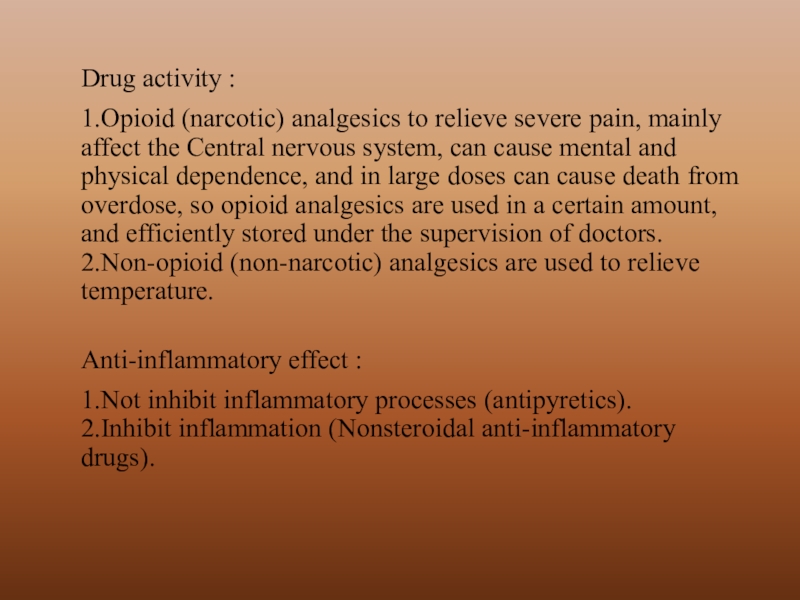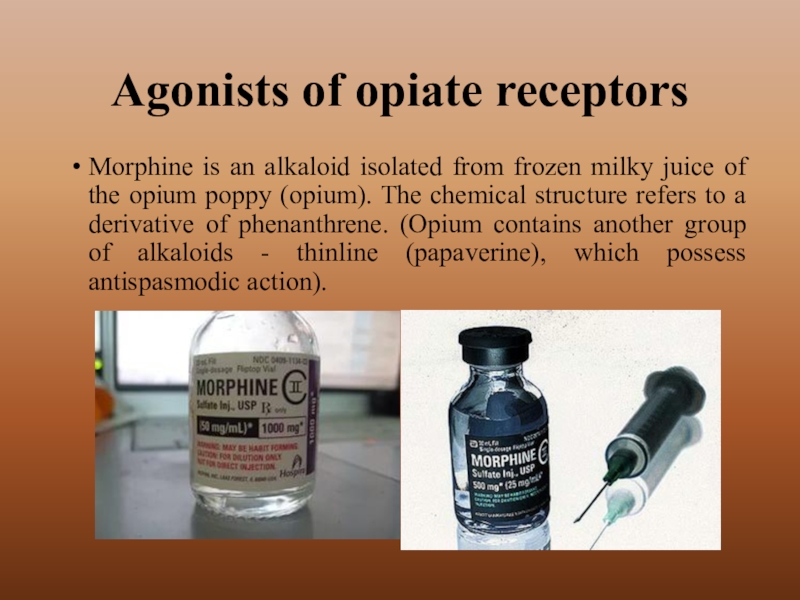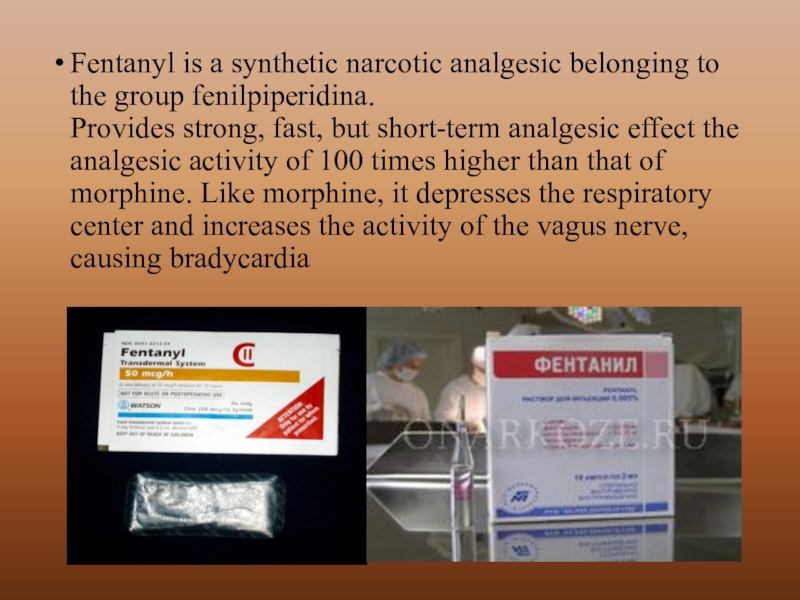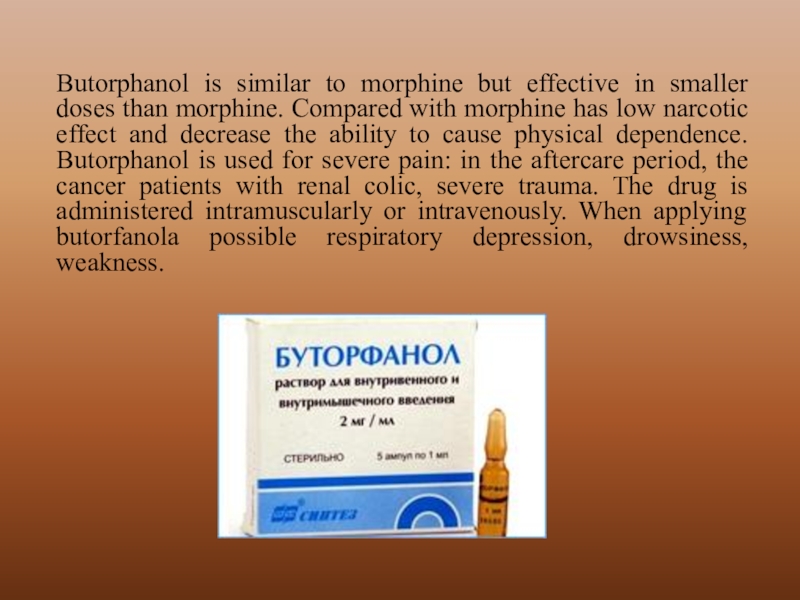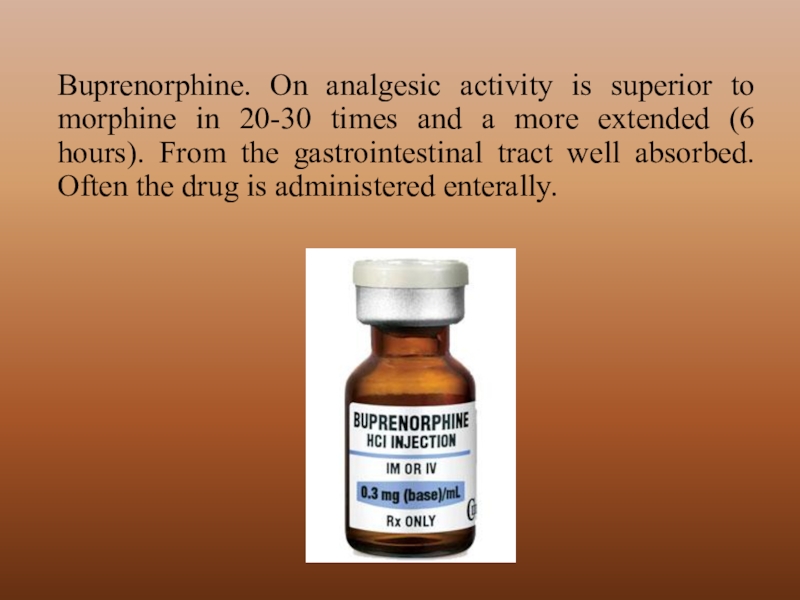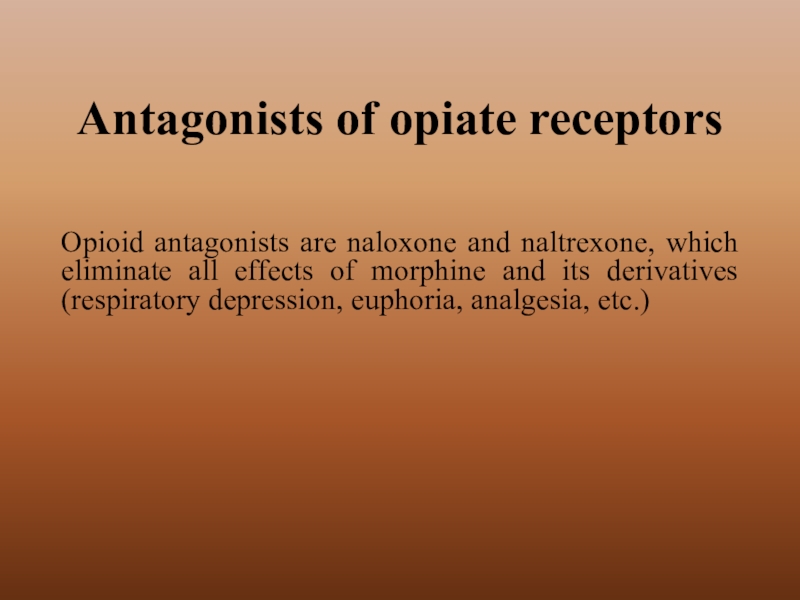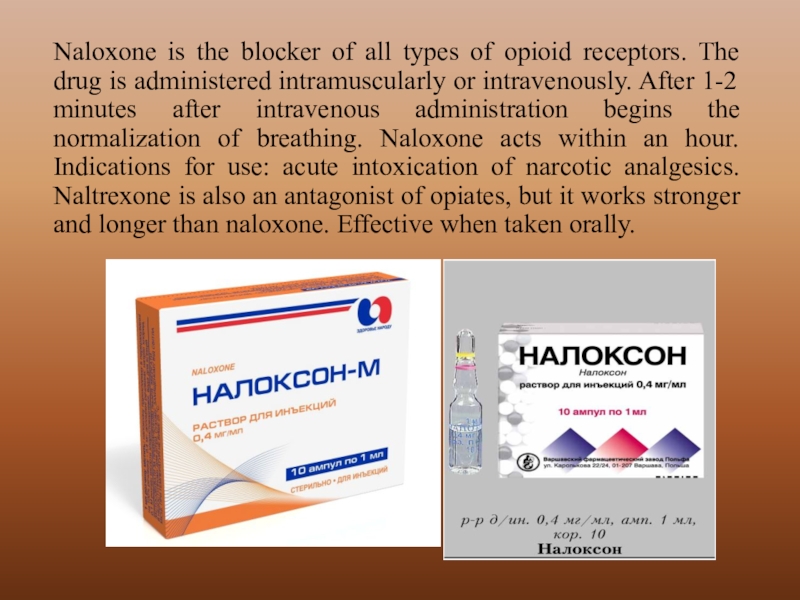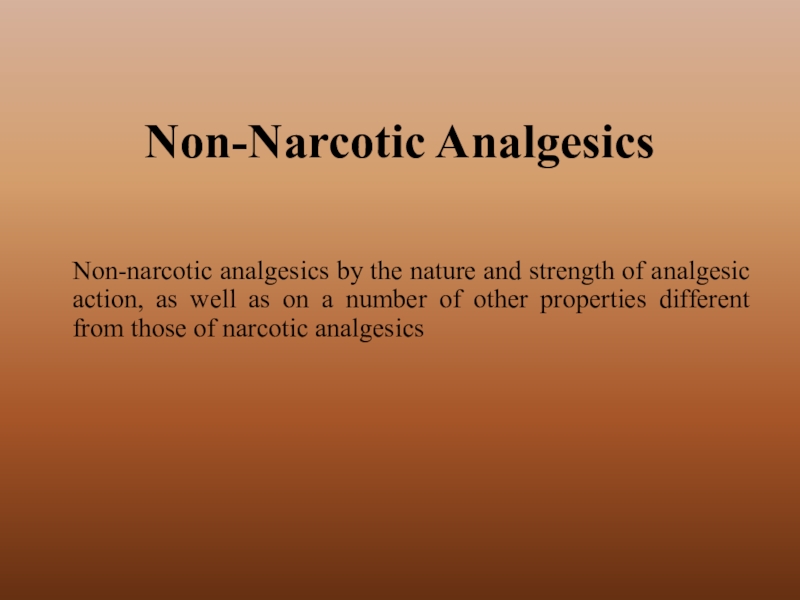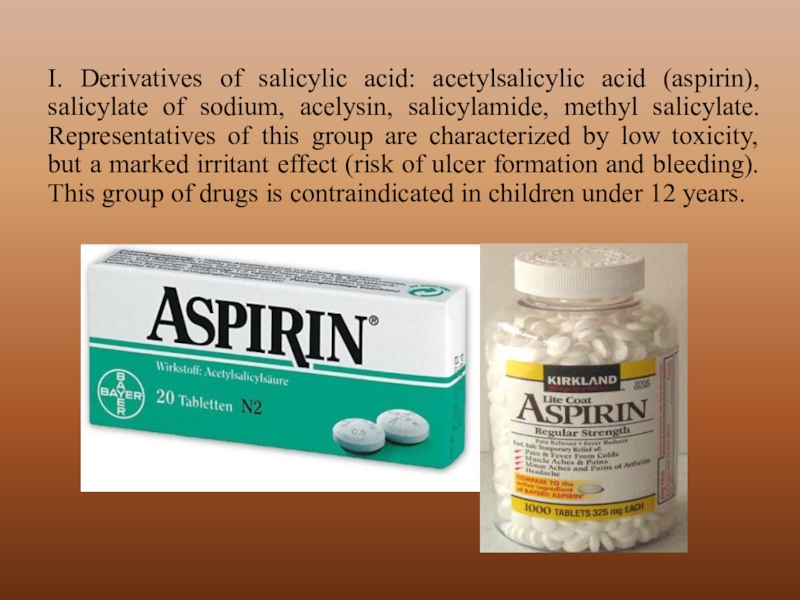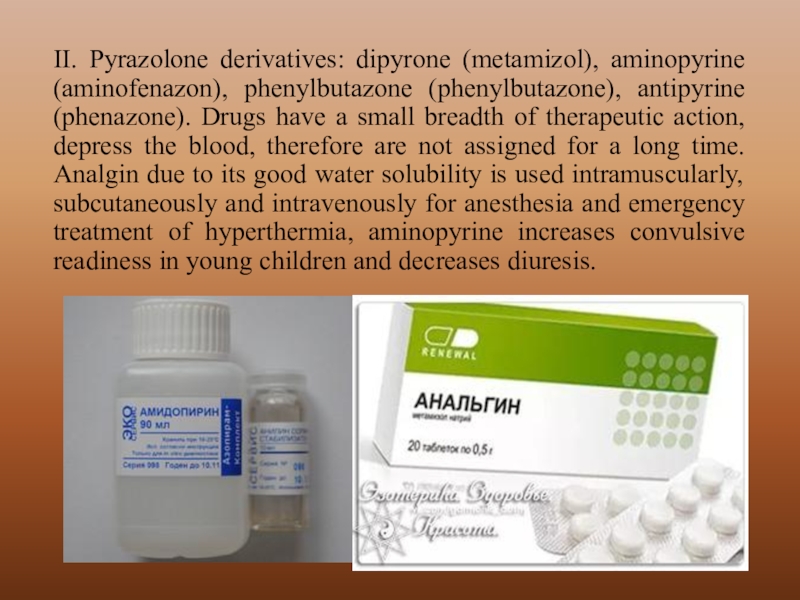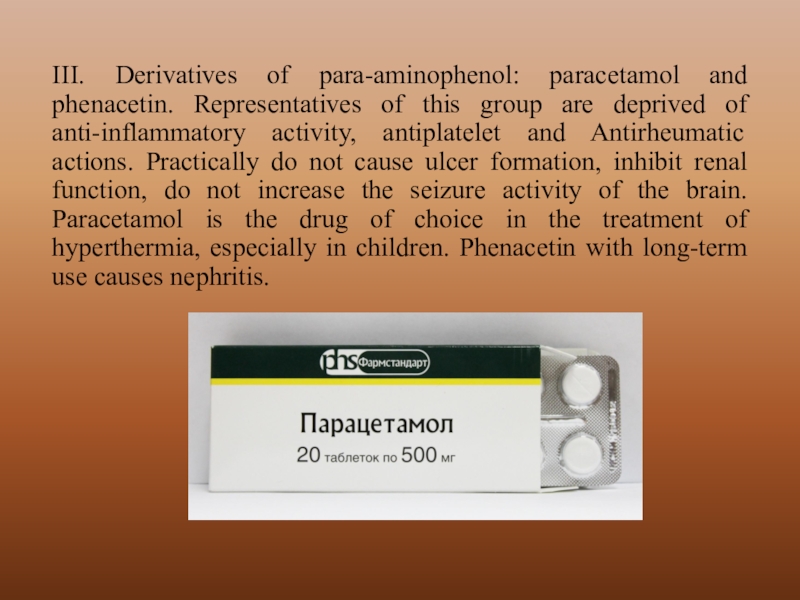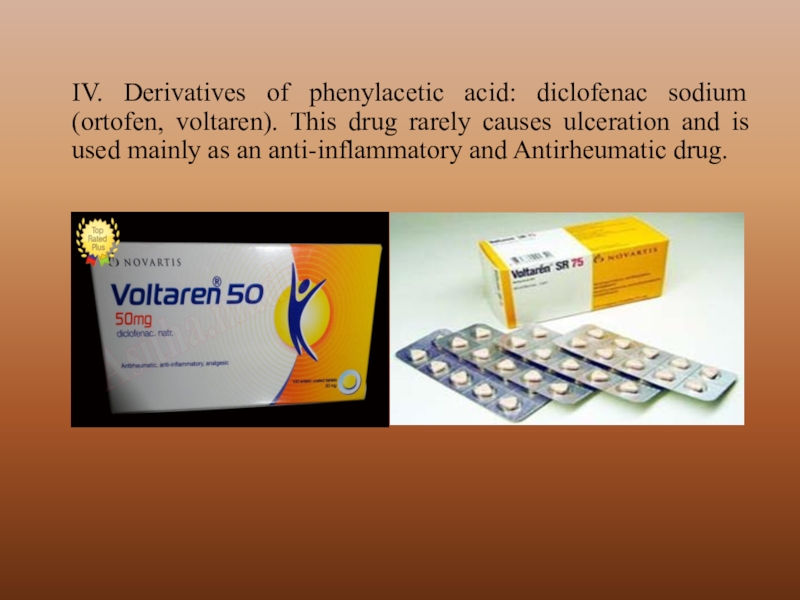Астрахань – 2017 г.
- Главная
- Разное
- Образование
- Спорт
- Естествознание
- Природоведение
- Религиоведение
- Французский язык
- Черчение
- Английский язык
- Астрономия
- Алгебра
- Биология
- География
- Геометрия
- Детские презентации
- Информатика
- История
- Литература
- Математика
- Музыка
- МХК
- Немецкий язык
- ОБЖ
- Обществознание
- Окружающий мир
- Педагогика
- Русский язык
- Технология
- Физика
- Философия
- Химия
- Шаблоны, фоны, картинки для презентаций
- Экология
- Экономика
Презентация, доклад по иностранному языку на тему Analgesics
Содержание
- 1. Презентация по иностранному языку на тему Analgesics
- 2. ContentHistoryClassificationAgonists of opiate receptorsAgonists-antagonists of opiate receptorsAntagonists of opiate receptorsNon-Narcotic Analgesics
- 3. HistoryBefore the advent of modern analgesics for
- 4. Classification Narcotic analgesics: 1.Agonists
- 5. Drug activity : 1.Opioid
- 6. Agonists of opiate receptorsMorphine is an alkaloid
- 7. Fentanyl is a synthetic narcotic analgesic belonging
- 8. Agonists-antagonists of opiate receptorsAgonists-antagonists act differently on
- 9. Butorphanol is similar to morphine but effective
- 10. Buprenorphine. On analgesic activity is superior to
- 11. Antagonists of opiate receptorsOpioid antagonists are naloxone
- 12. Naloxone is the blocker of all types
- 13. Non-Narcotic AnalgesicsNon-narcotic analgesics by the nature and
- 14. I. Derivatives of salicylic acid: acetylsalicylic acid
- 15. II. Pyrazolone derivatives: dipyrone (metamizol), aminopyrine (aminofenazon),
- 16. III. Derivatives of para-aminophenol: paracetamol and phenacetin.
- 17. IV. Derivatives of phenylacetic acid: diclofenac sodium
- 18. Thank you for your attention !
ContentHistoryClassificationAgonists of opiate receptorsAgonists-antagonists of opiate receptorsAntagonists of opiate receptorsNon-Narcotic Analgesics
Слайд 1 Государственное бюджетное учреждение Профессиональная образовательная организация «Астраханский базовый медицинский колледж» Предмет: «Иностранный
язык»
Тема: «Analgesics»
Преподаватель: Белянский А.А.
Слайд 2Content
History
Classification
Agonists of opiate receptors
Agonists-antagonists of opiate receptors
Antagonists of opiate receptors
Non-Narcotic Analgesics
Слайд 3History
Before the advent of modern analgesics for pain relief were used
in various ways to relieve the pain: for example, during the operation patients have drunk alcohol, scopolamine, opium, Indian hemp.
In folk medicine used willow bark. The willow bark contains the substance salicin, which on hydrolysis is converted into salicylic acid, which has anti-inflammatory and analgesic effect.
Acetylsalicylic acid was synthesized in 1853 and was used in medicine until 1899: during these 46 years of accumulated data on its effectiveness in arthritis and good endurance.
In folk medicine used willow bark. The willow bark contains the substance salicin, which on hydrolysis is converted into salicylic acid, which has anti-inflammatory and analgesic effect.
Acetylsalicylic acid was synthesized in 1853 and was used in medicine until 1899: during these 46 years of accumulated data on its effectiveness in arthritis and good endurance.
Слайд 4Classification
Narcotic analgesics:
1.Agonists of opioid receptors (morphine,
promedol, fentanyl)
2.Agonists-antagonists and partial agonists of opioid receptors (pentazocine, butorphanol, buprenorphine)
Non-narcotic analgesics:
1.Salicylic acid derivatives: aspirin, sodium salicylate. 2.Pyrazolone derivatives: dipyrone, phenylbutazone, aminopyrine. 3.Aniline derivatives — phenacetin, paracetamol. 4.Alkane acid derivatives — ibuprofen, flurbiprofen, diclofenac sodium. 5.Anthranilic acid (mefenamovaya acid and floranova). 6.Other — piroxicam, dimexide, hotazel.
In biochemical activity :
1.Acting on the center of pain (blocks the production of prostaglandins). 2.Blocking the transmission of pain signals in the brain.
Non-narcotic analgesics:
1.Salicylic acid derivatives: aspirin, sodium salicylate. 2.Pyrazolone derivatives: dipyrone, phenylbutazone, aminopyrine. 3.Aniline derivatives — phenacetin, paracetamol. 4.Alkane acid derivatives — ibuprofen, flurbiprofen, diclofenac sodium. 5.Anthranilic acid (mefenamovaya acid and floranova). 6.Other — piroxicam, dimexide, hotazel.
In biochemical activity :
1.Acting on the center of pain (blocks the production of prostaglandins). 2.Blocking the transmission of pain signals in the brain.
Слайд 5 Drug activity :
1.Opioid (narcotic) analgesics to relieve
severe pain, mainly affect the Central nervous system, can cause mental and physical dependence, and in large doses can cause death from overdose, so opioid analgesics are used in a certain amount, and efficiently stored under the supervision of doctors.
2.Non-opioid (non-narcotic) analgesics are used to relieve temperature.
Anti-inflammatory effect :
1.Not inhibit inflammatory processes (antipyretics). 2.Inhibit inflammation (Nonsteroidal anti-inflammatory drugs).
Anti-inflammatory effect :
1.Not inhibit inflammatory processes (antipyretics). 2.Inhibit inflammation (Nonsteroidal anti-inflammatory drugs).
Слайд 6Agonists of opiate receptors
Morphine is an alkaloid isolated from frozen milky
juice of the opium poppy (opium). The chemical structure refers to a derivative of phenanthrene. (Opium contains another group of alkaloids - thinline (papaverine), which possess antispasmodic action).
Слайд 7Fentanyl is a synthetic narcotic analgesic belonging to the group fenilpiperidina. Provides
strong, fast, but short-term analgesic effect the analgesic activity of 100 times higher than that of morphine. Like morphine, it depresses the respiratory center and increases the activity of the vagus nerve, causing bradycardia
Слайд 8Agonists-antagonists of opiate receptors
Agonists-antagonists act differently on different types of opiate
receptors: some receptors they stimulate (agonist effect), or block (antagonistic) effect. These drugs, having a strong analgesic effect, have less severe side effects than morphine.
Слайд 9Butorphanol is similar to morphine but effective in smaller doses than
morphine. Compared with morphine has low narcotic effect and decrease the ability to cause physical dependence. Butorphanol is used for severe pain: in the aftercare period, the cancer patients with renal colic, severe trauma. The drug is administered intramuscularly or intravenously. When applying butorfanola possible respiratory depression, drowsiness, weakness.
Слайд 10Buprenorphine. On analgesic activity is superior to morphine in 20-30 times
and a more extended (6 hours). From the gastrointestinal tract well absorbed. Often the drug is administered enterally.
Слайд 11Antagonists of opiate receptors
Opioid antagonists are naloxone and naltrexone, which eliminate
all effects of morphine and its derivatives (respiratory depression, euphoria, analgesia, etc.)
Слайд 12Naloxone is the blocker of all types of opioid receptors. The
drug is administered intramuscularly or intravenously. After 1-2 minutes after intravenous administration begins the normalization of breathing. Naloxone acts within an hour. Indications for use: acute intoxication of narcotic analgesics. Naltrexone is also an antagonist of opiates, but it works stronger and longer than naloxone. Effective when taken orally.
Слайд 13Non-Narcotic Analgesics
Non-narcotic analgesics by the nature and strength of analgesic action,
as well as on a number of other properties different from those of narcotic analgesics
Слайд 14I. Derivatives of salicylic acid: acetylsalicylic acid (aspirin), salicylate of sodium,
acelysin, salicylamide, methyl salicylate. Representatives of this group are characterized by low toxicity, but a marked irritant effect (risk of ulcer formation and bleeding). This group of drugs is contraindicated in children under 12 years.
Слайд 15II. Pyrazolone derivatives: dipyrone (metamizol), aminopyrine (aminofenazon), phenylbutazone (phenylbutazone), antipyrine (phenazone).
Drugs have a small breadth of therapeutic action, depress the blood, therefore are not assigned for a long time. Analgin due to its good water solubility is used intramuscularly, subcutaneously and intravenously for anesthesia and emergency treatment of hyperthermia, aminopyrine increases convulsive readiness in young children and decreases diuresis.
Слайд 16III. Derivatives of para-aminophenol: paracetamol and phenacetin. Representatives of this group
are deprived of anti-inflammatory activity, antiplatelet and Antirheumatic actions. Practically do not cause ulcer formation, inhibit renal function, do not increase the seizure activity of the brain. Paracetamol is the drug of choice in the treatment of hyperthermia, especially in children. Phenacetin with long-term use causes nephritis.
Слайд 17IV. Derivatives of phenylacetic acid: diclofenac sodium (ortofen, voltaren). This drug
rarely causes ulceration and is used mainly as an anti-inflammatory and Antirheumatic drug.
